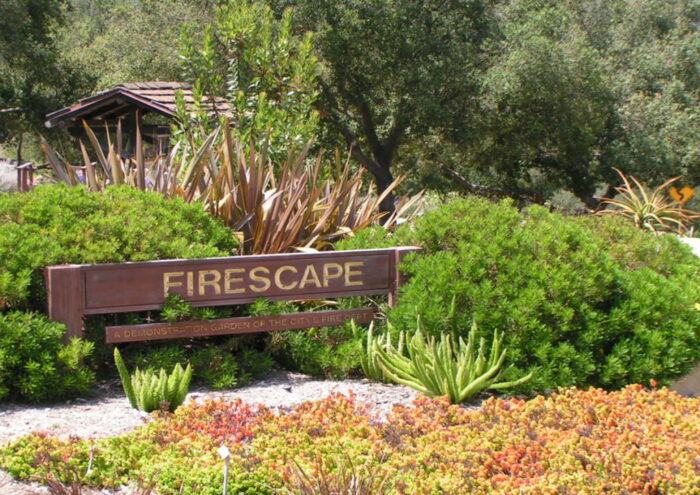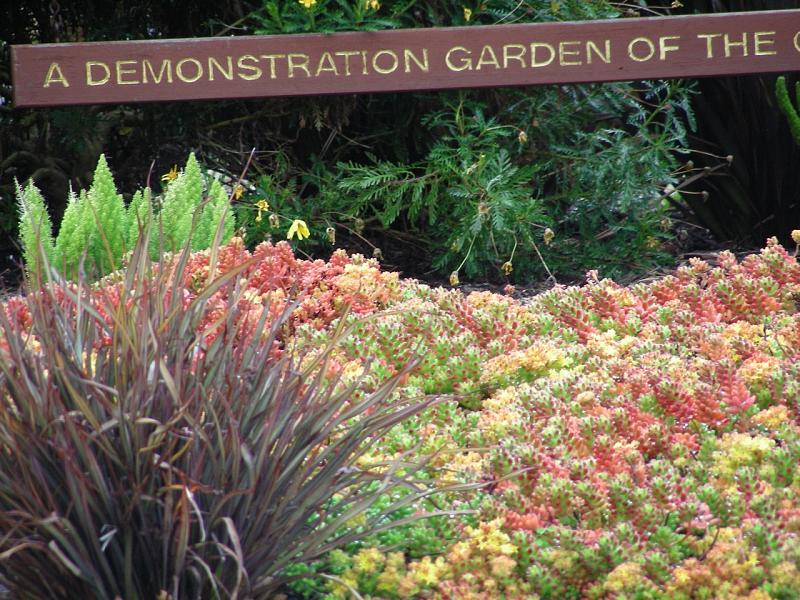
Here is some information that might help save your home from a fire. If you live in a high-fire area, you should already know this stuff and be putting the principles into practice.
Wildfires can happen anywhere
Perhaps you are thinking, “Wildfires only happen out west. I’ll just worry about floods and tornadoes and blizzards and hailstorms and plagues of flying garden gnomes.”
Ponder this: The last time I checked, Myrtle Beach, South Carolina, was on the Atlantic coast. We call that “back east.” The fire that broke out there on April 24, 2009, burned 19,600 acres and consumed 80 homes. So listen up, please. To paraphrase Bob Dylan, the climate, it is a changin’.
|
|
|
I was at a presentation by Santa Barbara’s retiring fire chief, Ron Prince, a few weeks ago regarding the devastating Tea fire we experienced in November 2008. Ron and his staff were describing how at the peak of the firestorm, “strike teams” cruised into actively burning neighborhoods and decided where to take a stand. If the landscaping around a house jeopardized the movement of the firefighters and equipment, or contributed to the fuel load around the structure, these guys hit the accelerator on their 38,000-lb. rigs and went looking for better odds. I can’t say I blame them.
Creating a fire-wise landscape
The key to creating a fire-wise landscape around your home is to provide “defensible space.” In other words, you increase the odds of surviving a wildfire by managing the fuel around your property. There are no “fireproof” plants. OK, if you want to quibble, the kelp that grows off the shores of Santa Barbara beaches has never burned in a brushfire. I’m no expert, but I think it might have to do with being surrounded by seawater. But I digress.

How to firescape
Your objective is to minimize the amount of fuel that fire can feed off of. Aside from the obvious steps—cutting back tree branches that overhang your roof, eliminating flammable construction materials like wood decking, and clearing dried weeds and grasses—there is a systematic zone approach that makes a lot of sense.
Picture a bull’s-eye with roughly circular zones emanating outward from your house.
Zone 4 is the outermost portion of your property. For homes right on the “fringe of civilization,” this is called the wildland/urban interface, where native vegetation comes right up to your property line. In Santa Barbara, these plants are usually part of the chaparral ecology—plants designed by nature to burn. It’s part of the renewal process.
Visualize islands of vegetation separated by areas of low-fuel plants or at least 20 feet of mulch. This arrangement breaks up the fuel that could serve as a fuse leading to your house. The technical term for it is “discontinuous fuel source.”
Zone 3, closer to the house, consists of low-growing, fine-leafed plants that burn quickly and produce short flame lengths. This way, the fire consumes the fuel in a flash and the spread of the flames is reduced. A good palette might be gazania daisy, Lavandula ‘Provence’, Geranium incanum, and Lantana montevidensis. There are sure to be similar plants in your gardening zone.
Zone 2 is juicy. No, not the clothing brand adorning the posteriors of plush sweat pants. I’m talking about plants that store a lot of moisture in their tissue. This should include very low-growing plants that are harder to burn. In SoCal, we have a diverse palette to choose from: Agave, Aloe, Crassula, and Agapanthus are a few of the soft-tissue varieties, complemented by low growers like Nepeta faassenii, our native Heuchera maxima, and Erigeron karvinskianus.
Zone 1 is where you make your last stand. Give up the picturesque, old-school idea of foundation plantings. The last thing you want to do is mound fuel against the house; you might as well put gasoline in your sprinkler system. The plants you choose can come from the same palette as Zone 2, but it’s a good idea to include some irrigated lawn and spaces with inert materials like gravel mulch.
There are no guarantees that heeding these guidelines will save your home if a wildfire is raging your way. You can create the textbook-perfect fire-wise garden and still lose everything. If you embrace and implement these ideas you might have passing fire crews look up your driveway and think, “It looks like they did it right. Let’s make a stand.”

Informative Links
Federal Alliance for Safe Homes – Disaster preparedness nonprofit
Debra Lee Baldwin article – “Did Succulents Save Her Home?” L.A. Times



















Comments
Thanks for the well-written and timely post. Great photos of the Santa Barbara Firescape demo and shout-out to Owen Dell. The national Firewise program recently interviewed him for one of our "How To" newsletters (see link to How To Guides at Firewise You Can Use tab on http://www.firewise.org).
The only differences in our advice might be the approach. We encourage homeowners to start at the house and work their way out, beginning with a "fuel-free" area 3-5 feet from the home and attachments, and extending out along the zones. The "big idea" is to minimize potential ignition of the structure from the radiant heat of large flames, surface fire touching the structure, and from embers landing on or near the home. In addition to the important landscaping considerations, the home should have fire-resistant features, especially a nonflammable roof. You're correct that Firewise landscaping gives firefighters the chance to save the home. It also could prevent the home igniting at all, which is key during an extreme event where firefighting resources are maxed out.
Billy:
Really interesting article and sidebar. I'll definitely forward this on to my friends in the area. As you've shown, firewise gardens are certainly beautiful. Incidentally, I've heard Owen Dell speak in Santa Barbara -- very interesting guy with lots of sustainable gardening advice to share.
All the best, Teresa
Hi, Billy -- Here in San Diego county, we have the same concerns as you do in Santa Barbara. Your posting is timely and contains excellent information. Btw, I'm teaching a class this fall at Quail Botanical Gardens on "Waterwise, Firewise Landscaping" based on my book, "Designing with Succulents." These plants, which by definition store water in fleshy leaves and stems, don't transmit fire, are excellent choices for firebreaks, are noninvasive, and thrive in Southern CA gardens. -- Debra Lee Baldwin
Billy, thank you so much for writing such an important piece. It's all too easy to be complacent — even here in the flammable West — and think that because we're "in town" or "close to the water" or "have a small lot" we're somehow immune from fire. I'm sharing your article with every garden owner I know.
-John
Wise words for all of us who design in fire-prone areas...as a former resident of Santa Barbara I was horrified to see the fire map (oh no! not the Botanical Gardens!) and these conflagrations seem to be happening more and more...we had weeks of ash-enhanced sunsets here in Northern California last summer. Thank you!
Great article, Billy. For some good hands-on material, Ventura and L.A. County residents can get a copy of the SAFE Fire Safety Calendar by writing to:
SAFE Landscapes
UCCE - Los Angeles and Ventura County
Natural Resources Department
4800 E. Cesar Chavez Ave.
Los Angeles CA 90022
Excellent post and also educational with the use of terms like "discontinuous fuel source." Believe it or not, we face a similar problem living in the Flint Hills in Kansas where the prairies are burned yearly to control noxious invaders and enhance their nutritional value for grazing. One of my solutions, that you didn't mention specifically, was to surround the house with a circle of some kind of stone, asphalt or concrete...sidewalks, raised beds edged with stone, asphalt drivway, etc so that there is a completely nonflammable barrier encircling. It's detailed further in a gardening book I wrote about the Flint Hills; "Garden Musings", available on Amazon.
@Mike_Taylor
Thanks for refering to us (I'm the Director of the SAFE Landscapes Program). You can also view most of our information, and download a copy of our Calendar at
http://ucanr.org/safelandscapes
In the coming year we will be putting the information in a more web-friendly format too.
I also want to echo Michelle's comment - landscaping is a very imporant piece of a fire-safe homestead, but the house is integral - we often see people with great landscaping, or brush "clearance", but their home is not maintained to withstand an ember storm. You can find out much more about how to improve the house itself at with our Homeowner's Wildfire Assessment and Homeowners's Wildfire Mitigation Guide, both available through links at the website above, or by going to the UC Center for Fire Research and Outreach at http://firecenter.berkeley.edu/
I know for sure that my garden is really really safe but I just want yo give it an upgrade these days. I will call at a specialized brand doing gardens cause I want to love spending time in it and things like that. But after all nothing compares to Phoenix landscaping
Amazing article. I have read your article. Started to read it But I am reading one for seo services primelis, I will talk to you later.
Amazing article. I have read your article. Started to read But I am reading one for seo services primelis, I will talk to you later.
Log in or create an account to post a comment.
Sign up Log in